ECS LIVA Z3 Plus Review: Compact Comet Lake NUC Clone Cuts Corners
by Ganesh T S on December 22, 2020 8:00 AM ESTUL Benchmarks - PCMark and 3DMark
This section deals with a selection of the UL Futuremark benchmarks - PCMark 10, PCMark 8, and 3DMark. While the first two evaluate the system as a whole, 3DMark focuses on the graphics capabilities.
PCMark 10
UL's PCMark 10 evaluates computing systems for various usage scenarios (generic / essential tasks such as web browsing and starting up applications, productivity tasks such as editing spreadsheets and documents, gaming, and digital content creation). We benchmarked select PCs with the PCMark 10 Extended profile and recorded the scores for various scenarios. These scores are heavily influenced by the CPU and GPU in the system, though the RAM and storage device also play a part. The power plan was set to Balanced for all the PCs while processing the PCMark 10 benchmark.
The core clock speed advantage of the Core i5-10210U compared to the processor in the NUC8i5BEK gives the LIVA an advantage in the productivity workload. However, other scores are pulled down due to the single-channel memory. In fact, the only PC the LIVA Z3 Plus is consistently ahead of is the Gemini Lake-based LIVA Z2.
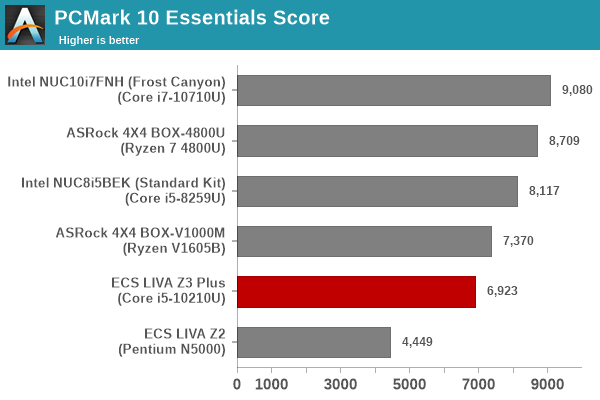
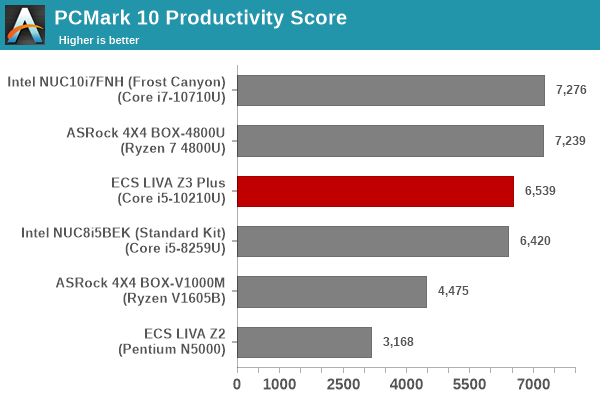
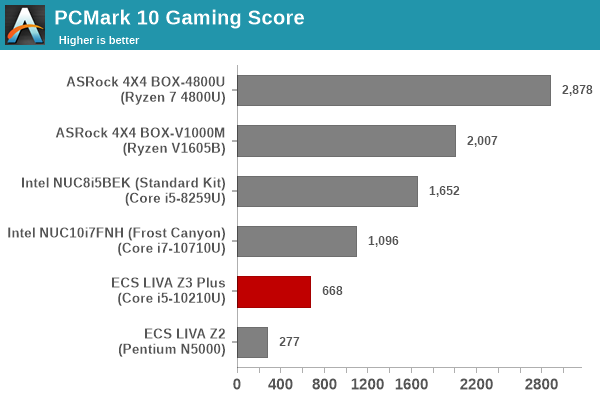
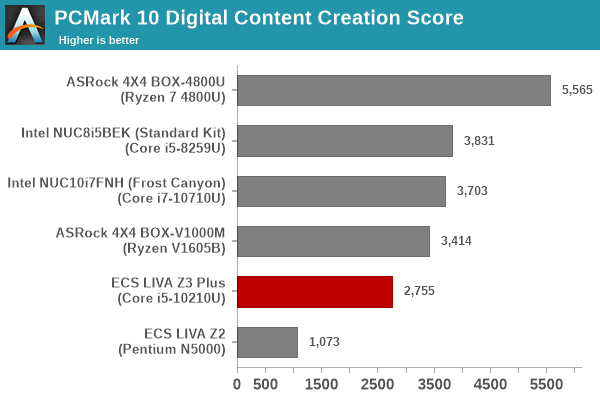
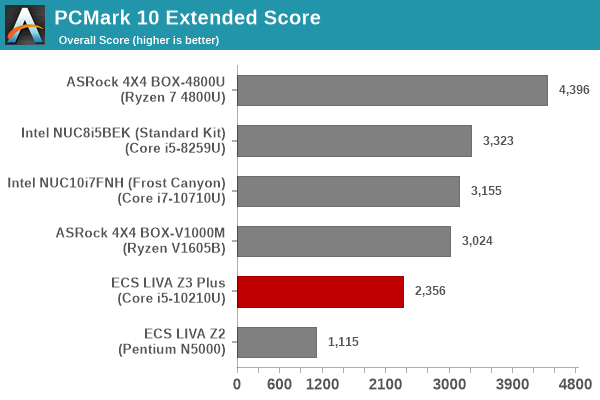
PCMark 8
We continue to present PCMark 8 benchmark results (as those have more comparison points) while our PCMark 10 scores database for systems grows in size. PCMark 8 provides various usage scenarios (home, creative and work) and offers ways to benchmark both baseline (CPU-only) as well as OpenCL accelerated (CPU + GPU) performance. We benchmarked select PCs for the OpenCL accelerated performance in all three usage scenarios. These scores are heavily influenced by the CPU in the system. With GPU capabilities in the mix, the AMD-based mini-PCs manage a significant lead over the LIVA Z3 Plus. Other numbers follow the same comparative trend as seen in the previous benchmarks.

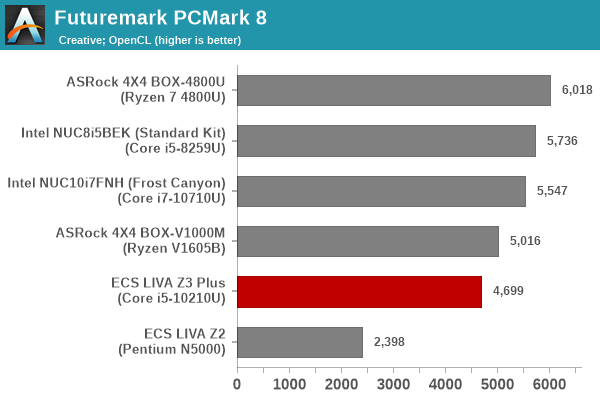
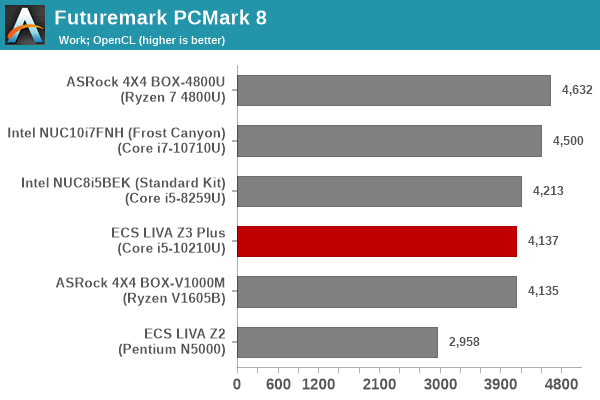
3DMark
UL's 3DMark comes with a diverse set of graphics workloads that target different Direct3D feature levels. Correspondingly, the rendering resolutions are also different. We use 3DMark 2.4.4264 to get an idea of the graphics capabilities of the system. In this section, we take a look at the performance of the ECS LIVA Z3 Plus across the different 3DMark workloads. The scores indicate that the single-channel memory acts as a huge dampener for performance in graphics workloads due to GPU bandwidth limitations.
3DMark Ice Storm
This workload has three levels of varying complexity - the vanilla Ice Storm, Ice Storm Unlimited, and Ice Storm Extreme. It is a cross-platform benchmark (which means that the scores can be compared across different tablets and smartphones as well). All three use DirectX 11 (feature level 9) / OpenGL ES 2.0. While the Extreme renders at 1920 x 1080, the other two render at 1280 x 720. The graphs below present the various Ice Storm worloads' numbers for different systems that we have evaluated.
| UL 3DMark - Ice Storm Workloads | |||
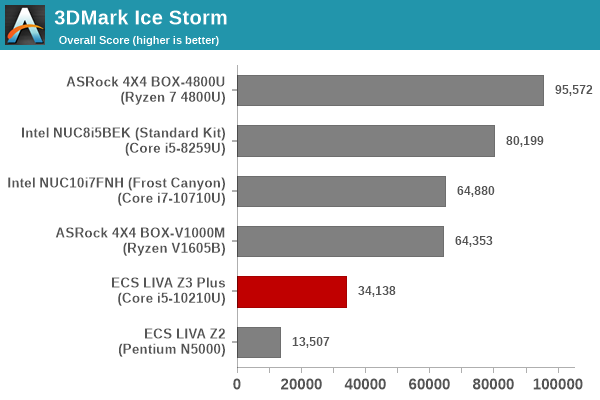
3DMark Cloud Gate
The Cloud Gate workload is meant for notebooks and typical home PCs, and uses DirectX 11 (feature level 10) to render frames at 1280 x 720. The graph below presents the overall score for the workload across all the systems that are being compared.

3DMark Sky Diver
The Sky Diver workload is meant for gaming notebooks and mid-range PCs, and uses DirectX 11 (feature level 11) to render frames at 1920 x 1080. The graph below presents the overall score for the workload across all the systems that are being compared.
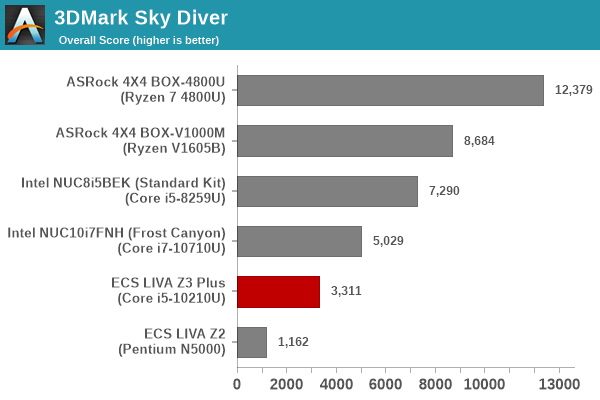
3DMark Fire Strike Extreme
The Fire Strike benchmark has three workloads. The base version is meant for high-performance gaming PCs. Similar to Sky Diver, it uses DirectX 11 (feature level 11) to render frames at 1920 x 1080. The Ultra version targets 4K gaming system, and renders at 3840 x 2160. However, we only deal with the Extreme version in our benchmarking - It renders at 2560 x 1440, and targets multi-GPU systems and overclocked PCs. The graph below presents the overall score for the Fire Strike Extreme benchmark across all the systems that are being compared.
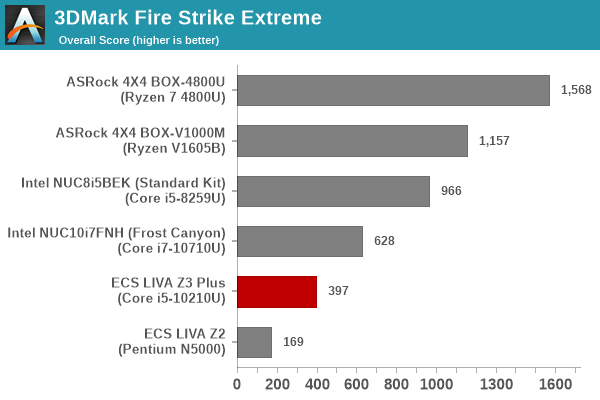










15 Comments
View All Comments
JfromImaginstuff - Tuesday, December 22, 2020 - link
Waiting for the guy who says,"where's the and variant" or something along those linesedzieba - Tuesday, December 22, 2020 - link
And the inevitable "AMD exists so nobody is allowed to review Intel products!!1!" brigade.nandnandnand - Tuesday, December 22, 2020 - link
No AMD, no buy.stephenbrooks - Tuesday, December 22, 2020 - link
The ASRock 4X4 is in the comparison table, so your AMD SFFPC is there.Hul8 - Wednesday, December 23, 2020 - link
Also, I think as long as AMD keeps bringing new architectures to mobile/APUs late, and Intel keeps leading their new tech with mobile chips, most manufacturers will prioritize Intel for these systems. Doesn't hurt that they can get sweet bundle deals for WiFi 6 and Ethernet, too.chrnochime - Thursday, December 24, 2020 - link
Well it'd be AMD and not "and" for starters LOLShowtime - Tuesday, December 22, 2020 - link
This looks better than the Nuc to me, but all 4 USB ports on the front, make a no go. There's always 2-3 things plugged in, and I prefer those things in the back of the case. It being a bad value proposition is unfortunate. This is like many tech items, that could have been great, but will end up on sale for 50% off next year. Will cite this article when that happens.Impetuous - Tuesday, December 22, 2020 - link
Agree with you on the ports. I have the original LIVA Z for TV / media use and would much prefer to route external HDDs and Skype cameras from the back to keep cords away from grasping toddlers. Only thing I want up front is the wireless keyboard USB. All ports on the back is more of a deal breaker than the price for me...Impetuous - Tuesday, December 22, 2020 - link
Sorry, all ports on front*The_Assimilator - Tuesday, December 22, 2020 - link
Allow me to introduce you to a simple and inexpensive device called a "USB hub".